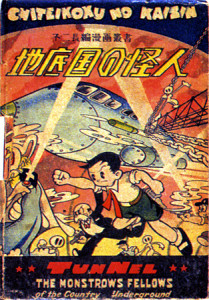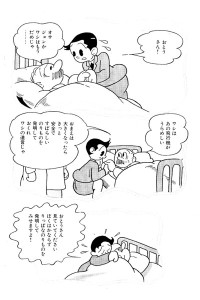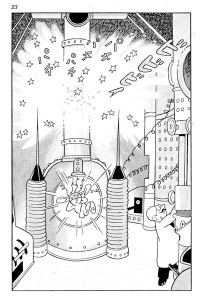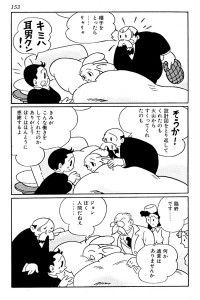Mysterious Underground Men, The (Manga)
Also known as 地底国の怪人 (Chiteikoku no Kaijin)
| English Title: | The Mysterious Underground Men |
| In English? | Yes |
| Japanese Title: | 地底国の怪人 Chiteikoku no Kaijin |
| Type: | Book |
| Original run: | 1948/02/20 |
| Published by: | Fuji Shobo |
| Volumes: | 1 MT-253 |
The Mysterious Underground Men (1948), was originally published as a stand-alone book by Fuji Shobo and released on February 20, 1948. One of his earliest feature-length works, Tezuka considered it his very first “story manga” – despite the fact that fails to take into account either of his earlier adventures, King Kong (1947) and The Golden Bat (1947).
What it’s about
As the story opens, the boy-hero John must deal with his father’s death in an airplane crash. John‘s father tells his young son that his final wish is for him to create a safer means of transport. John swears that he will, and cries as his father passes away.
Meanwhile, scientists perform a series of experiments on a rabbit to give him the intelligence of a human. While the experiment is a success, the humanoid rabbit named Mimio is prevented from exploring the outside world. Unable to contain his curiosity, he escapes but, after unintentionally scaring the locals, he is hounded and chased by the police until he seeks shelter at John‘s house. John shares his dream with Mimio about creating a Trans-Earth Train, which would travel through the Earth’s core.
After it’s completion, John and Mimio begin their subterranean travel through to the Earth’s core, but soon discover an underground civilization determined to conquer the Earth’s surface.
What you should know
The Mysterious Underground Men (1948) represents an early transitional milestone in Tezuka’s work. As he points out in the afterword to the Osamu Tezuka Complete Works edition (MT-253), he considered his early works, such as Doctor Mars (1947), to be heavily influenced by “prewar manga”. Later expanding on this notion in a 1988 interview, Tezuka explained how his use of this term referred to the “preconceived notion that manga was for fun and laughs”, and that, prior to the release of The Mysterious Underground Men (1948), manga generally featured little to no tragedy. However, in The Mysterious Underground Men (1948), Tezuka created the character of Mimio who, not only cries after he is forced to leave John and Uncle Bill but also, in a shocking twist of fate, sacrifices himself and dies at the story’s climax – something which was extremely shocking to the children of the time. By introducing the tragedy, Tezuka allowed the manga to more closely echo life and thus feature more drama than was generally seen perviously.
Tezuka was inspired by many sources, sometimes event “borrowing” plot or story elements from other works of fiction. As such, it should come as no surprise that the idea for the subterranean denizens in The Mysterious Underground Men (1948) came from the American sci-fi film serial Flash Gordon’s Trip to Mars (1934) – more specifically, from ‘The Deadly Ray from Mars’ in which Flash battles against clay people who are impervious to bullets. They are led by a queen who can turn people into clay with a sapphire around her neck and put people to sleep with a ring on her finger, very similar to the queen’s abilities in Tezuka’s tale.
There are also certain elements inspired by the popular German sci-fi novel, Der Tunnel (1913), by Bernhard Kellermann of which Tezuka was a fan. In fact, Tezuka’s work was originally going to be titled The Tunnel, and was only changed at the publisher’s insistence.
As with many of Tezuka’s early works, The Mysterious Underground Men (1948) makes great use of the Star System – prominently featuring Kenichi as “John”, Shunsaku Ban as “Uncle Bill”, as well as Hamegg and Mimio under their own names. What is perhaps most interesting though, is that it also features the comedic trio of Ramune, Kalpis and Soda – in one of their few appearances before Tezuka dropped Soda and parred the group down to the more well-known comedic duo instead.
Finally, it is interesting to note that, given the available technology at the time, The Mysterious Underground Men (1948) was published using the Kakihan method. However, as the process involved transferring the artwork to zinc printing plates by technicians, Tezuka was never satisfied with the end results, basically disowning the artwork produced using this method as the drawings were not a clear reproduction of his own creation. As a result of Tezuka’s dissatisfaction with the printing method, he chose to redraw the story twice – first as Earth Tunnel (1951-52) and again as Adventure 21 (1970-71).
Where you can get it
Luckily for English-speakers,The Mysterious Underground Men (1948) was published as a 160-page hardcover book in October 2013 as part of PictureBox‘s “Ten Cent Manga” imprint. Although not a true replica edition, it reproduces the look of age and wear one would expect from a work originally published in 1948. The book also features a supplemental essay by noted manga historian Ryan Holmberg.






